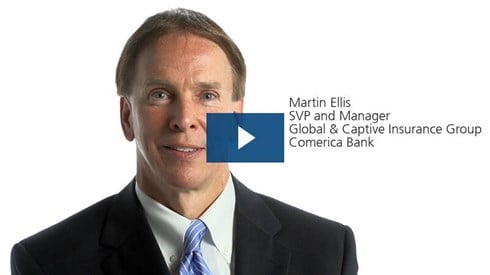Remove Impacts of Emotion and Reaction When Investing for Captives

August 26, 2019

As part of our ongoing commitment to provide thoughtful commentary concerning issues impacting captives and the broader insurance markets, we spoke with Stephen Nedwicki, institutional investment strategist with Comerica Bank. Our discussion focused on captive investment strategies and the outlook for investment portfolios.
Steve, how did you become involved in the investment management business and, more specifically, working with captive insurers?
I started working with investment portfolios for nonprofit organizations in 2000 as part of my responsibilities as a relationship manager with Comerica Trust. In 2014, my responsibilities expanded to include portfolios for captive insurers, as several Comerica Bank captive insurance clients were looking for solutions for their investment portfolios.
Before we delve into investment portfolios and capital markets, let's talk about investment policy statements. What are the key components of a captive insurer's investment policy, and why is each of them important?
A written investment policy statement (IPS) is necessary for structuring the investment portfolio. The IPS guides the investment goals and documents the approved asset classes, target allocations, reporting, performance measurement criteria, and any restrictions banks providing letters of credit or Regulation 114 trust agreement beneficiary place on the captive.
There has been a long-running debate as to whether captive insurers should mirror their investment policies after their larger traditional property-casualty brethren or take a slightly more aggressive path. Where does Comerica believe captives should be positioned, and why?
Capital preservation is key to most captive insurance programs and is quite often the first investment objective. Comerica focuses on capital preservation and will incur only as much risk as is necessary to achieve the client's objectives. During negative market cycles, we resist the temptation to time when to enter or exit individual investments, asset classes, or markets by maintaining a disciplined and consistent approach.
From a macro standpoint, how does Comerica assemble a captive insurer's investment portfolio? Are you a proponent of more active investment management or a passive style linked more to generating index-like returns?
At Comerica, we construct portfolios by focusing our efforts on controlling the factors that have the largest impact on long-term investment results. These efforts are as follows.
- Asset Allocation. According to studies, more than 93 percent of the variability of investment returns is due to asset allocation. The timing and choice of individual investments have less impact. Being in the "right" combination of asset classes is the most important component of performance.
- Fees. Investment costs add up over time and can significantly impact long-term results if not managed effectively. For our institutional client base, we start with a low management fee. We then utilize passive low-cost investments to construct the portfolio whenever possible and supplement with active management.
- Trading Costs. We keep trading costs to a minimum by effectively managing portfolio rebalancing and by using individual securities and cost-efficient investment vehicles, such as exchange-traded funds, if allowed by the investment policy statement.
Active portfolio managers have struggled over the last decade or so, especially when trying to justify their fees, on a net of fee return basis against a benchmark. As a captive owner/manager, how long should you allow a manager to underperform before you start to think about making a change?
To make sure the impacts of emotion and reaction are absent from the investment process, investors should typically evaluate managers through a market cycle of 3 to 5 years. This should help to prevent the temptation to time when to enter or exit individual investments, asset classes, or markets.
In our current environment, do you worry more about inflation or disinflation, and why?
The Comerica Bank June 2019 US Economic Outlook is titled "The L4L Economy." L4L is a tactic defined by former Federal Reserve chairman Ben Bernanke as a monetary policy tool. It stands for "lower for longer." In Mr. Bernanke's framework, "lower for longer" means that the Federal Reserve may need to signal that it will keep interest rates lower for a longer period than the current conditions may indicate.
We believe that the lower for longer concept also applies more broadly to the overall US and global economies. L4L also describes overall economic growth, inflation, and interest rates generally, beyond the specific application of monetary policy. In the L4L economy, real gross domestic product growth rates are lower than what many people think is normal. Inflation is also lower than expected. Indeed, central banks globally, including the Federal Reserve, are asking themselves how to conduct monetary policy in an era of persistently low inflation. Weaker growth, and demand for capital, plus weaker inflation, mean that interest rates are also going to be lower for longer than many of us feel is normal.
Over the last year or so, it appeared captives were beginning to see their book yield start to climb again after a long period of decline. Now, with central bankers talking about or actually cutting rates, have we seen the highs in yields, and should captives prepare for another period of falling portfolio returns?
Bond yields are less than they were 12 months ago. Since fixed income returns move in the opposite direction of interest rates, captive insurers have seen the market value of their bond portfolios increase, while their investment yield has declined.
As expected, the Fed cut the funds rate by 25 basis points at its July Federal Open Market Committee meeting. It cited global weakness, muted inflation, and trade-related concerns to justify the policy change. This was the first rate reduction since December 2008 and follows a tightening stance that included 9 rate hikes over a 3-year period (from December 2015 to December 2018). Federal Reserve Chairman Jerome Powell said the Fed will "act as appropriate" in order to maintain the economic expansion. However, he reiterated the rate cut was not the beginning of a long easing cycle but a midcycle adjustment.
On the equity side, we expect the domestic economy, inflation readings, sluggish growth in Europe and China, and policy-related headwinds from trade disputes to contribute to continuing stock market volatility.
When you speak with captive insurers' boards, how difficult is it to get them to understand and accept realistic rates of return for their portfolios?
Comerica focuses on three basic principles as the foundation of any investment management philosophy. These are communicated to the board to make sure that they understand and accept realistic rates of returns:
- Comerica will act in the captive's best interest as a prudent steward of the investments;
- Comerica believes in a goal-oriented approach to meet the objectives of capital preservation, cash flow, yield, and performance; and
- Comerica provides a well-disciplined, consistent, and repeatable process over time.
As a corollary to the question above, gazing into your crystal ball, where do you see total returns for equities and bonds going over the next 2–3 years?
It is not easy to predict when interest rates will change and when markets will rise or fall, based on history. Rather than predict what will happen, next month or next year, we emphasize a disciplined approach to investments. A well-defined investment philosophy may help captives navigate the unpredictable ups and downs of the financial markets.
Any other thoughts or comments you would like to share on the markets or portfolio construction with our readers?
Discipline, consistency, communication, and a repeatable process are essential to successful investing and are the basics needed for the impacts of emotion and reaction to be removed from the investment process.
Thanks for your time, Steve.
(Article photo of Stephen Nedwicki is courtesy of Comerica Bank.)
August 26, 2019

